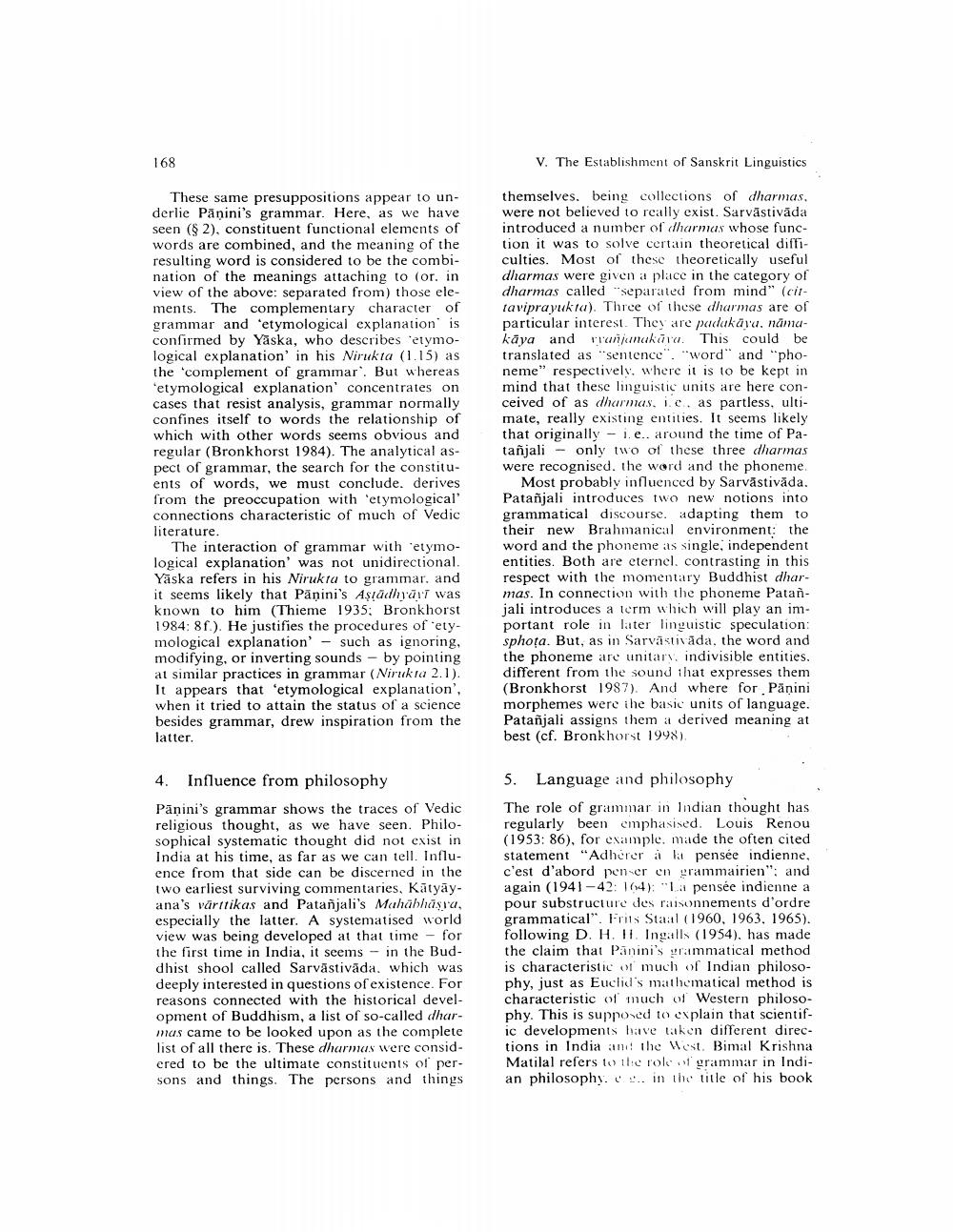Book Title: Relationship Between Linguistics And Other Sciences In India Author(s): Johannes Bronkhorst Publisher: Johannes Bronkhorst View full book textPage 3
________________ 168 These same presuppositions appear to underlie Panini's grammar. Here, as we have seen (§ 2), constituent functional elements of words are combined, and the meaning of the resulting word is considered to be the combination of the meanings attaching to (or in view of the above: separated from) those elements. The complementary character of grammar and 'etymological explanation is confirmed by Yaska, who describes etymological explanation' in his Nirukta (1.15) as the 'complement of grammar. But whereas 'etymological explanation' concentrates on cases that resist analysis, grammar normally confines itself to words the relationship of which with other words seems obvious and regular (Bronkhorst 1984). The analytical aspect of grammar, the search for the constituents of words, we must conclude. derives from the preoccupation with 'etymological' connections characteristic of much of Vedic literature. The interaction of grammar with etymological explanation' was not unidirectional. Yaska refers in his Nirukta to grammar, and it seems likely that Panini's Aṣṭādhyārī was known to him (Thieme 1935; Bronkhorst 1984: 8f.). He justifies the procedures of "etymological explanation' such as ignoring, modifying, or inverting sounds by pointing at similar practices in grammar (Nirukta 2.1). It appears that 'etymological explanation', when it tried to attain the status of a science besides grammar, drew inspiration from the latter. 4. Influence from philosophy Panini's grammar shows the traces of Vedic religious thought, as we have seen. Philosophical systematic thought did not exist in India at his time, as far as we can tell. Influence from that side can be discerned in the two earliest surviving commentaries, Katyāyana's varttikas and Patanjali's Mahabhāṣya, especially the latter. A systematised world view was being developed at that time for the first time in India, it seems in the Buddhist shool called Sarvästiväda. which was deeply interested in questions of existence. For reasons connected with the historical development of Buddhism, a list of so-called dharmas came to be looked upon as the complete list of all there is. These dharmas were considered to be the ultimate constituents of persons and things. The persons and things V. The Establishment of Sanskrit Linguistics. themselves. being collections of dharmas. were not believed to really exist. Sarvästivāda introduced a number of dharmas whose function it was to solve certain theoretical difficulties. Most of these theoretically useful dharmas were given a place in the category of dharmas called "separated from mind" (cittaviprayukta). Three of these dharmas are of particular interest. They are padakāya, nāmakaya and ryanjanakāva. This could be translated as "sentence". "word" and "phoneme" respectively, where it is to be kept in mind that these linguistic units are here conceived of as dharmas, ie, as partless, ultimate, really existing entities. It seems likely that originally - i. e.. around the time of Patañjali only two of these three dharmas were recognised. the word and the phoneme. Most probably influenced by Sarvāstivāda. Patanjali introduces two new notions into grammatical discourse. adapting them to their new Brahmanical environment: the word and the phoneme as single, independent entities. Both are eternel. contrasting in this respect with the momentary Buddhist dharmas. In connection with the phoneme Patanjali introduces a term which will play an important role in later linguistic speculation: sphota. But, as in Sarvästivada, the word and the phoneme are unitary, indivisible entities. different from the sound that expresses them (Bronkhorst 1987). And where for Panini morphemes were the basic units of language. Patanjali assigns them a derived meaning at best (cf. Bronkhorst 1998). 5. Language and philosophy The role of grammar in Indian thought has regularly been emphasised. Louis Renou (1953: 86), for example, made the often cited statement "Adhérer à la pensée indienne, c'est d'abord penser en grammairien"; and again (1941-42: 104): "La pensée indienne a pour substructure des raisonnements d'ordre grammatical". Frits Staal (1960, 1963, 1965). following D. H. H. Ingalls (1954), has made the claim that Panini's grammatical method is characteristic of much of Indian philosophy, just as Euclid's mathematical method is characteristic of much of Western philosophy. This is supposed to explain that scientific developments have taken different directions in India and the West. Bimal Krishna Matilal refers to the role of grammar in Indian philosophy. ee.. in the title of his bookPage Navigation
1 2 3 4 5 6 7 8
